Weekly Advanced Technologies〔71〕

Weekly Advanced Technologies〔71〕丨The World's Smallest Miniature Medical Robot Breaks Through the "Impossible Trinity" of Existing Technologies丨Groundbreaking: The First Visual-Cued Remote Sensing Multimodal Large Model Debuts
The research team of SHEN Yajing at the Department of Electronic and Computer Engineering (ECE) of Hong Kong University of Science and Technology has successfully developed one of the world's smallest multifunctional surgical robots. This miniature medical surgical robot has a diameter of just 0.95 mm, breaking through the "impossible trinity" of current technological limitations.
Recently, the Data Fluidics Team from the Advanced Research Institute of Multidisciplinary at the Beijing Institute of Technology has developed the world's first remote-sensing multimodal large model with visual prompts, named EarthMarker. It's no exaggeration to say that EarthMarker can be described as "versatile".
Based on the weekly diary of technology provided by the daily list of the NCSTI online service platform, we launch the column "Weekly Advanced Technologies" at the hotlist of sci-tech innovation. Today, let's check out No.71.
1. Nature Communications丨The World's Smallest Miniature Medical Robot Breaks Through the "Impossible Trinity" of Existing Technologies
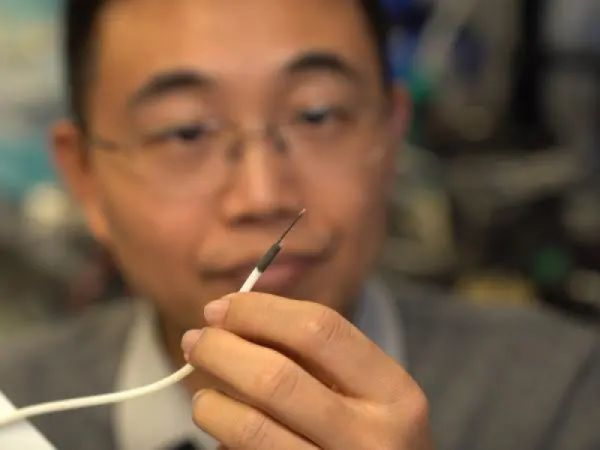
Associate professor SHEN Yajing of the Department of Electronic and Computer Engineering at the Hong Kong University of Science and Technology led a team to successfully develop one of the world's smallest multifunctional surgical robots. This miniature medical surgical robot has a diameter of just 0.95 mm, 60% slimmer than existing ones. It integrates three functions into one, breaking through the “impossible trinity” of current technological limitations. Featuring a high-definition camera, it extends the obstacle-detection distance to around 9.4 mm, a tenfold leap compared to the theoretical limit. Its movement precision has been refined to under 30 microns, making it more compact and nimble. Additionally, it can remarkably expand the imaging area by about 25 times beyond the inherent imaging ratio of the central beam.
The robot can assist medical personnel in sampling, delivering drugs and performing laser thermotherapy procedures inside the human body. Its obstacle detection distance performance has been increased by 10 times, which helps to apply minimally invasive surgery to the end of the bronchial tubes, fallopian tubes and other tiny luminal branches inside the body, thus expanding the scope of its application.
Micro manipulators present a plethora of advantages. They possess the remarkable capability to access narrow cavities, which not only enables minimally-invasive procedures but also promotes swift patient recovery while keeping the risk of infection extremely low.
At present, micro-robots are playing a crucial role in treating a wide spectrum of diseases. For instance, in cardiac surgery, they assist in the precise placement of coronary stents, ensuring better blood flow restoration. In surgeries for gastric and duodenal ulcers, they perform laparoscopic resections with high precision, minimizing damage to surrounding tissues. Looking ahead, the team has a clear plan to continuously enhance the robot's performance, aiming to further revolutionize the field of medical treatment.
2. IEEE TGRS丨Groundbreaking: The First Visual-Cued Remote Sensing Multimodal Large Model Debuts
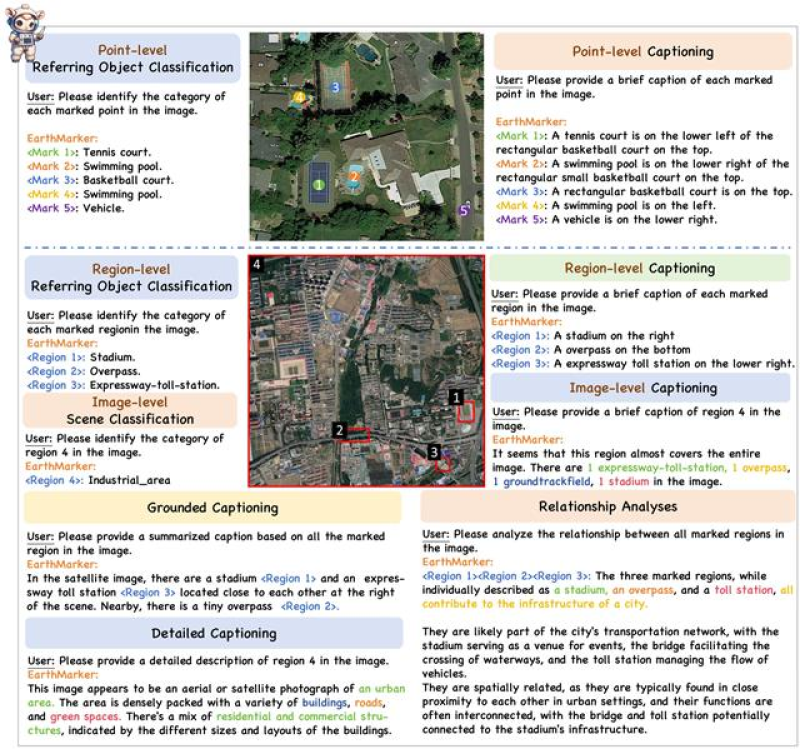
EarthMarker is capable of multi-granularity remote sensing image interpretation, enabling multi-task inference.
Recently, the Data Fluidics Team from the Advanced Research Institute of Multidisciplinary at the Beijing Institute of Technology has developed the world's first remote-sensing multimodal large model with visual prompts, named EarthMarker. It's no exaggeration to say that EarthMarker can be described as "versatile".
The EarthMarker has enabled multi-granularity (e.g., image - level, region - level, and point - level) remote sensing image interpretation and has excelled at a variety of visual tasks, including scene classification, specified object classification, image description, and relationship analysis. In addition, the team has proposed the first large - scale multimodal dataset for remote sensing visual cues. This dataset contains approximately 3.65 million multimodal {image - point - text} and {image - area - text} pairwise data, and it has been fully open-sourced.
The EarthMarker has successfully carried out complex visual inference tasks, particularly excelling in remote-sensing target relationship analysis tasks where it outperforms GPT-4V. It showcases remarkable analytical capabilities through a well - structured process. First, it summarizes the areas identified by visual cues as distinct elements within the airport environment. Subsequently, it clusters areas of the same category together. Based on these clusters, it infers the different functions of these annotated areas in the airport setting. This systematic approach allows EarthMarker to effectively analyze the grouped areas and accurately deduce the various functions of the labeled regions in the airport environment.
3. Nature Communications丨Industrial Method for Electrochemical Uniform Monolayer Graphene Oxide Preparation Found by Researchers
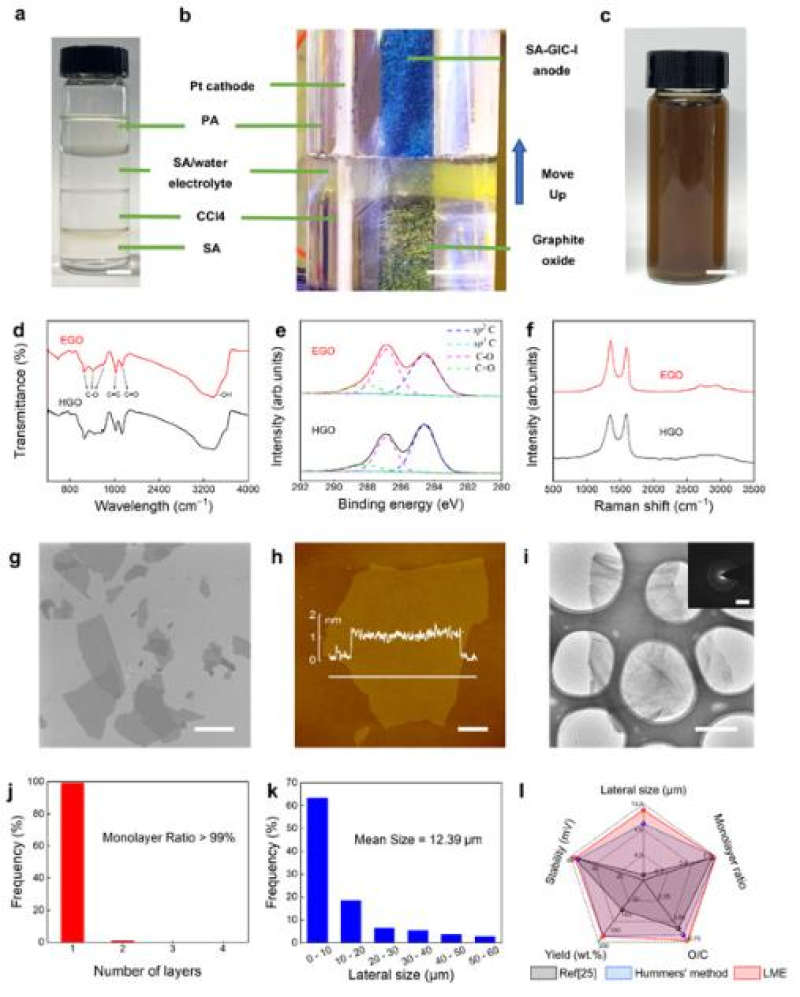
Micro-liquid membrane electrolysis (LME) method and its prepared Graphene oxide
Graphene oxide (GO), a crucial type of graphene material, boasts various unique properties distinct from graphene. It's currently the most widely used 2D material, having been industrially applied in thermal management and composite materials. For example, it can improve heat dissipation in thermal management and enhance the strength of composites. Additionally, it shows great application potential in material separation and biomedicine.
Currently, the batch production of graphene oxide (GO) predominantly employs the chemical oxidation method, with the Hummers' method being a well - known example. In this approach, GO is synthesized by reacting graphite with potent oxidizing agents like concentrated sulfuric acid, concentrated nitric acid, and potassium permanganate.
This chemical reaction has a long-standing history of over 150 years. However, the extensive use of a large quantity of strong oxidizing agents brings about several issues. There is a significant risk of explosion during the reaction process, which poses a serious threat to production safety. Moreover, it causes severe environmental pollution as the by - products and waste from these reactions can be harmful to the ecosystem. The high cost associated with the use of these agents and the necessary safety measures has emerged as a bottleneck, hindering the further development of the GO industry.
The research team led by REN Wencai from the Department of Advanced Carbon Materials at the Shenyang National Laboratory for Materials Science, Institute of Metal Research, Chinese Academy of Sciences, has invented the liquid micro - film electrolysis (LME) method. This method precisely controls the diffusion of water, achieving a dynamic balance between the oxidation of water electrolysis and the adsorption, desorption, and delamination of water. As a result, it has realized the industrial-scale continuous production of uniform single-layer graphene oxide (GO).
The single-layer ratio of the produced GO is ≥99%, and the yield can reach approximately 180 wt.%. Meanwhile, the cost is only one-seventh of that of the Hummers' method. The LME method enables effective control over the oxidation degree and size of GO and allows for the preparation of GO through pure water electrolysis.
This work not only provides new insights into the electrochemical preparation of GO but also offers a low-cost, high-yield, and sustainable approach for the production of uniform single-layer GO, laying a foundation for the industrial production and application of GO.
4. Nature Electronics丨Inspired by the Human Brain: An In-Memory Sparsity Architecture Unlocks the Potential of 2D Semiconductors in AI
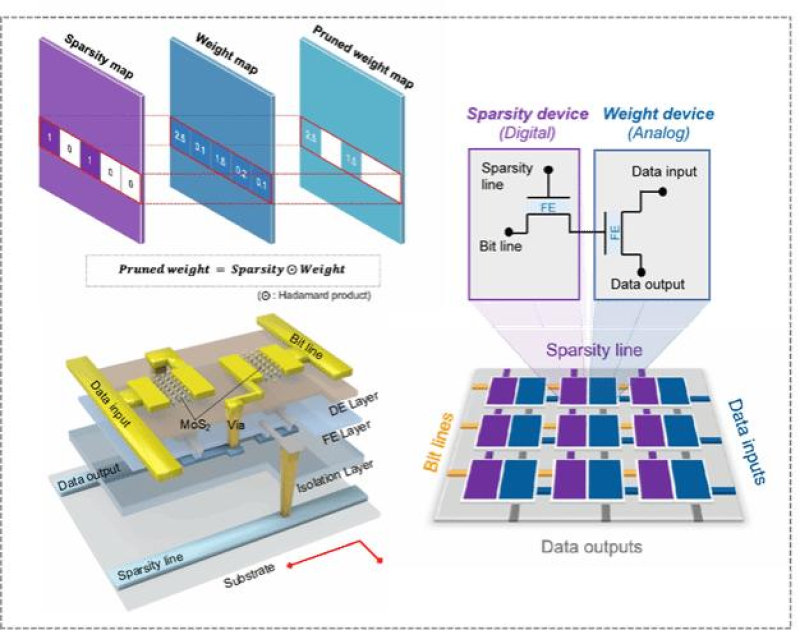
The design of "in-memory sparsity architecture
Sparsity is an inherent property of synapses in the human brain. During brain development, over half of synapses are pruned in a fine-grained, unstructured way, a key factor for the brain's high energy efficiency.Inspired by this, sparse neural networks were introduced in the 1990s and have since become a mainstream approach for AI lightweighting. While 90% of weights in these networks can be pruned, the pruning process demands repeated indexing with external storage, consuming over 90% of the system's energy and latency.
Similar to the von Neumann bottleneck of separating computation and storage, the indexing process is the bottleneck for sparse neural network hardware. Currently, the industry's mainstream solution is NVIDIA's large - granularity, structured pruning, starting from the A100 chip. It essentially reduces indexing overhead by sacrificing some accuracy but doesn't fundamentally solve the indexing bottleneck.
To address the issue of the mismatch between sparse neural network hardware and software, WANG Xinran and his collaborative team at Nanjing University took inspiration from the human brain and referred to neurobiological models. They discovered that the sparsity information should be located as close as possible to the weight information and directly participate in the sparse operation.
The team thus proposed an in-memory sparsity architecture for sparse neural networks. Leveraging 2D semiconductor ferroelectric transistor technology, they developed index - free units and conducted array-level on-chip demonstrations, breaking the bottleneck of sparse neural network hardware.
Their work showcases the potential of 2D semiconductors and other new materials and device technologies to boost AI hardware. 2D materials, compatible with low-temperature back-channel processes, can be 3D-monolithically integrated with mature silicon-based circuits. This breakthrough overcomes the interconnect density limitations of advanced packaging technologies and enhances the energy efficiency of near-memory and memory computing chips.
5. Nature Reviews Clean Technology丨The Future of Flash Joule Heating: Why It's Worth Watching
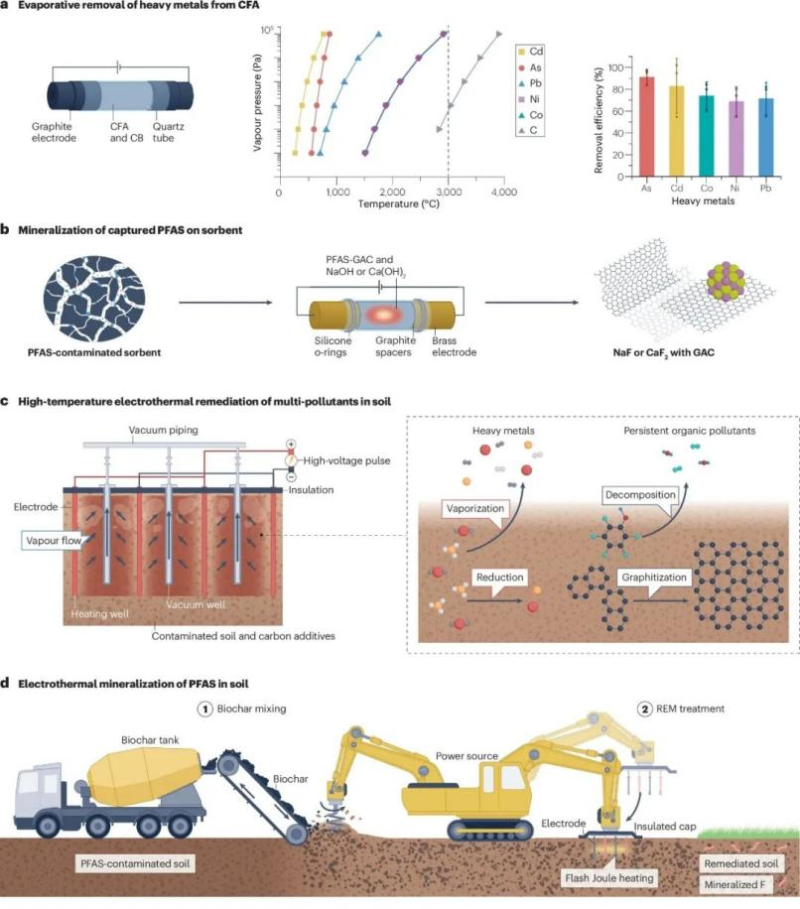
Application of flash joule heating technology in metal recycling, pollution remediation and solid waste upgrading and utilization
Flash joule heating technology (FJH), a novel direct electric heating technology, has been extensively studied in recent years. It features a wide temperature control range, ultra-fast processing, high energy efficiency, and low carbon emissions.
Recently, Deng Bing's group at Tsinghua University's School of Environment systematically reviewed FJH's scale - up progress and diverse applications in waste value - added use, environmental pollution remediation, and solid - phase material preparation. They conducted quantitative life-cycle and techno-economic analyses of typical applications and explored future development directions.
In 2020, scientists first proposed flash Joule heating, a novel direct resistance heating method. It operates on the principle of applying high - power, short - duration electrical pulses to the target material, generating heat directly and rapidly inside it without relying on a heating medium for heat transfer. This results in extremely high energy efficiency, with nearly 100% of electricity converted into heat. Compared to other heat treatment methods, flash Joule heating technology offers significant advantages in terms of high efficiency, ultra-fast processing, energy savings, and low carbon emissions.
The research team outlined the basic principles, power system design, reactor design, and scale-up process of flash Joule heating technology. They introduced its applications in material preparation, notably for high-quality carbon materials like graphene and carbon nanotubes, and the synthesis and phase control of inorganic solid-phase materials.
The team detailed its use in resource recycling and waste value-added utilization, covering strategic key metal separation, battery recycling, inorganic solid waste utilization, and converting carbon-rich solid waste (plastics and biomass) into functional carbon materials. They also discussed its application in environmental pollution remediation, such as soil contamination cleanup.
Techno-economic and life-cycle analyses of typical applications were conducted, proving its significant advantages in reducing energy consumption, carbon emissions, and process costs. As a clean and efficient heat treatment technology, flash Joule heating has become a scientific and technological hotspot and a disciplinary growth point in solid waste resource utilization, pollution remediation, and low - cost material preparation.
6. Nature Methods丨UDA-seq Supercharges Single-Cell Multi-Omics: Scaling to 100,000 Cells at High Speed
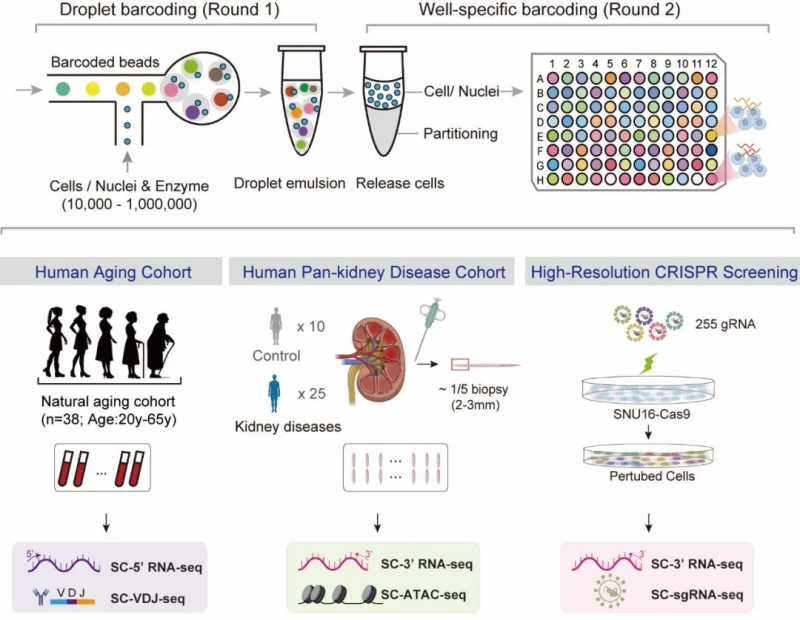
Universal high-throughput single-cell multi-omics technology UDA-seq Flowchart and application scenarios
Recently, the team led by Jiang Lan at the Computational Biology Division of the China National Center for Bioinformation independently developed a novel single-cell multi-omics sequencing technology, UDA-seq. This technology optimizes and upgrades the widely used droplet microfluidics platform through a combinatorial indexing approach, successfully decoupling cell throughput and false single-cell rates, thereby breaking through throughput limitations.
This technology is a broad-spectrum throughput enhancement strategy compatible with common single-cell multi-omics applications, including RNA-VDJ, RNA-ATAC, and RNA-CRISPR perturbation co-detection within the same cell. It has achieved a record-breaking single-channel throughput of over 100,000 cells while maintaining multimodality compatibility, representing a 10-20x improvement over existing methods. Additionally, by leveraging genetic diversity and bioinformatics-based demultiplexing, it has enabled label-free pooling of 20-40 human samples in a single channel, drastically reducing per-sample data costs.
This work has broken through the bottlenecks of existing technologies by dramatically increasing single-cell sequencing throughput while maintaining multimodal compatibility. It has demonstrated reliability and high quality in real-world samples and enabled efficient, low-cost data production. New algorithms have been developed to identify key cell subpopulations, regulatory networks, and factors linked to clinical phenotypes, establishing a novel research paradigm for large-scale studies of population health cohorts and disease cohorts (e.g., cancer, autoimmunity, infection).
Furthermore, this work has integrated modifications and enhancements to droplet microfluidic platforms, paving the way for scaling up to address the lack of multimodal, pre- and post-perturbation single-cell datasets. It is expected to provide critical data support for next-generation, multimodal virtual cell-based macromodels.
Columnist: Li Xiaoxiao
Translator: Liu Kaiyuan